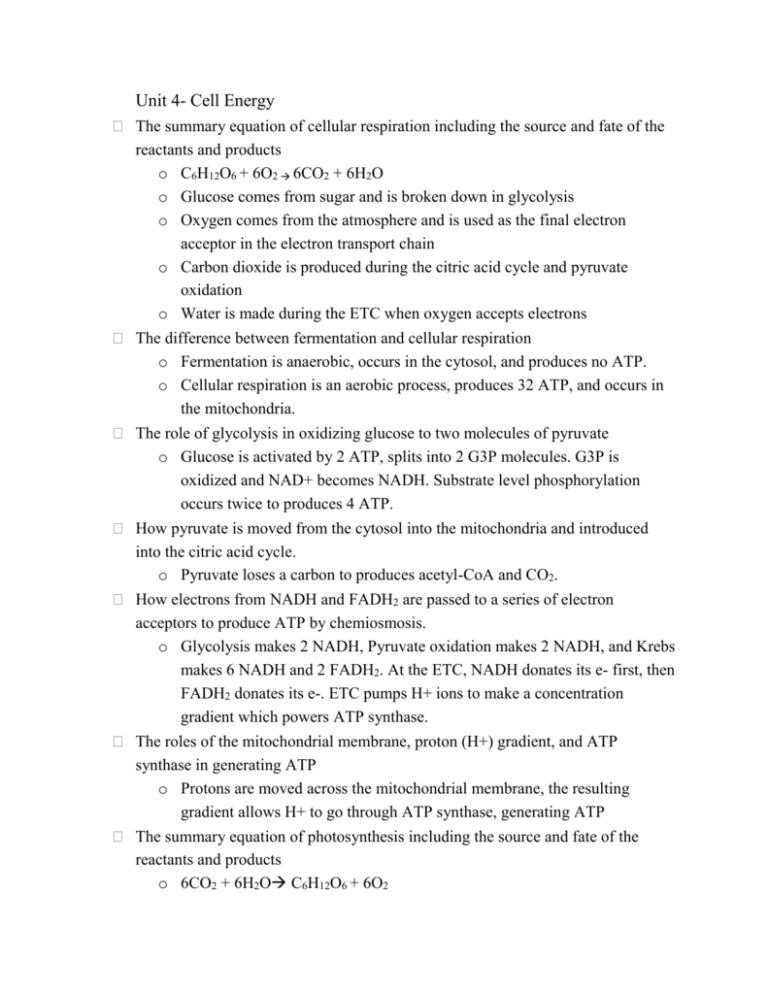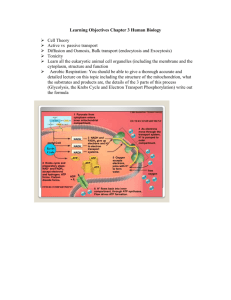Unit 4 WTK cell energy AP
advertisement

Unit 4- Cell Energy The summary equation of cellular respiration including the source and fate of the reactants and products o C6H12O6 + 6O2 6CO2 + 6H2O o Glucose comes from sugar and is broken down in glycolysis o Oxygen comes from the atmosphere and is used as the final electron acceptor in the electron transport chain o Carbon dioxide is produced during the citric acid cycle and pyruvate oxidation o Water is made during the ETC when oxygen accepts electrons The difference between fermentation and cellular respiration o Fermentation is anaerobic, occurs in the cytosol, and produces no ATP. o Cellular respiration is an aerobic process, produces 32 ATP, and occurs in the mitochondria. The role of glycolysis in oxidizing glucose to two molecules of pyruvate o Glucose is activated by 2 ATP, splits into 2 G3P molecules. G3P is oxidized and NAD+ becomes NADH. Substrate level phosphorylation occurs twice to produces 4 ATP. How pyruvate is moved from the cytosol into the mitochondria and introduced into the citric acid cycle. o Pyruvate loses a carbon to produces acetyl-CoA and CO2. How electrons from NADH and FADH2 are passed to a series of electron acceptors to produce ATP by chemiosmosis. o Glycolysis makes 2 NADH, Pyruvate oxidation makes 2 NADH, and Krebs makes 6 NADH and 2 FADH2. At the ETC, NADH donates its e- first, then FADH2 donates its e-. ETC pumps H+ ions to make a concentration gradient which powers ATP synthase. The roles of the mitochondrial membrane, proton (H+) gradient, and ATP synthase in generating ATP o Protons are moved across the mitochondrial membrane, the resulting gradient allows H+ to go through ATP synthase, generating ATP The summary equation of photosynthesis including the source and fate of the reactants and products o 6CO2 + 6H2O C6H12O6 + 6O2 o Carbon dioxide is from the atmosphere and fixed in the Calvin Cycle to produce G3P o Water is split in the light dependent stage to produce oxygen and build a concentration gradient o Glucose is produced through the Calvin cycle o Oxygen is produced at Photosystem II when water is split How leaf and chloroplast anatomy relate to photosynthesis o Leaves have pores called stomata which allow them to absorb CO2, which is necessary for carbon fixation in the dark reactions. Carbon fixation occurs in the mesophyll cells. Chloroplasts have pigments which allow them to capture light energy. They also have a double membrane that allows them to form a concentration gradient. How photosystems convert solar energy to chemical energy o Photosystems are made of a collection of pigments that capture light energy. The captured light energy is used by electrons to pump H+ across the membrane to build a concentration gradient. The gradient is used to power ATP synthase and produce ATP, How linear electron flow in the light reactions results in the formation of ATP, NADPH, and O2 o Solar energy energizes electrons which move down the ETC. Electrons move from PS II to the ETC to PS I. They can take a cyclic photophosphorylation pathway to continue building the H+ gradient or the non-cyclic photophosphorylation pathway to produce NADPH. Oxygen is produced when water is split in PS II. How the formation of a proton gradient in the light reactions is used to form ATP from ADP + inorganic phosphate by ATP synthase o Chemiosmosis. How the Calvin cycle uses the energy molecules of the light reactions (ATP and NADPH) to produce carbohydrates (G3P) from CO2 o Energy molecules allow for carbon fixation and reduction of CO2 to produce G3P, which is the precursor to carbohydrates.




